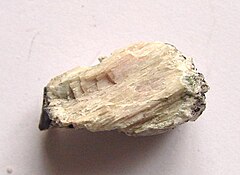Mendipite
| Mendipite | |
|---|---|

Mendipite from the Torr Works Quarry (Merehead Quarry), Cranmore, Somerset, England. Specimen size 2 cm
|
|
| General | |
| Category | Halide mineral |
|
Formula (repeating unit) |
Pb3Cl2O2 |
| Strunz classification | 3.DC.70 Oxyhalide |
| Dana classification | 10.3.1.1 |
| Crystal system | Orthorhombic |
| Crystal class | Dipyramidal (mmm) H-M symbol: (2/m 2/m 2/m) |
| Space group |
Pnma or P212121, |
| Unit cell | a = 9.52 Å, b = 11.87 Å, c = 5.87 Å; Z = 4 |
| Identification | |
| Formula mass | 724.50 g/mol |
| Color | Colorless to white, brownish cream, grey, yellowish, pink, red, or blue; nearly colorless in transmitted light. |
| Crystal habit | Columnar or fibrous aggregates, often radiated, and cleavable masses. |
| Cleavage | Perfect on {110}, fair on {100} and {010} |
| Fracture | Conchoidal to uneven |
| Mohs scale hardness | 2½ to 3 |
| Luster | Pearly to silky on cleavages; resinous to adamantine on fractures. |
| Streak | White |
| Diaphaneity | Translucent, rarely transparent |
| Specific gravity | 7.24 |
| Optical properties | Biaxial (+) |
| Refractive index | nα = 2.240, nβ = 2.270, nγ = 2.310 |
| Birefringence | δ = 0.070 |
| 2V angle | Measured: 90°, calculated: 84° |
| Solubility | Soluble in dilute nitric acid, HNO3 |
| References | |
Mendipite is a rare mineral that was named in 1939 for the locality where it is found, the Mendip Hills in Somerset, England. It is an oxyhalide of lead with formula Pb3Cl2O2.
Most references assert that mendipite crystallises in the orthorhombic crystal system, disphenoidal class 2 2 2, meaning that it has three mutually perpendicular axes of twofold symmetry, with space group P212121, meaning that each of these axes is a screw axis. One reference, however, gives the crystal class as orthorhombic m m m with space group Pnma, which has a higher symmetry. In each case the "P" means that the mineral has a primitive unit cell.
Unit cell parameters:
Mendipite is colorless to white, brownish cream, grey, yellowish, pink, red, or blue. It is nearly colorless in transmitted light. It has a white streak and its luster is pearly to silky on cleavages, and resinous to adamantine on fractures. The mineral is translucent, and rarely transparent. It is biaxial (+), with refractive indices Nx = 2.24, Ny = 2.27, Nz = 2.31. These values are quite high, compared with ordinary glass at 1.5. This is typical of lead minerals.
Mendipite is found in columnar or fibrous aggregates, often radiated but more rarely straight long fibers, and in cleavable masses. The cleavage is perfect on {110} and fair on {100} and {010}. Fracture is conchoidal (shell-like) to uneven and the mineral is soft, with hardness only 2½ to 3, a bit less than that of calcite. Because of the lead content the specific gravity is high, at 7.24, or 7 to 7.2, just a little less than that of mimetite, another lead mineral. Mendipite is soluble in dilute nitric acid, HNO3. It is not radioactive.
...
Wikipedia
